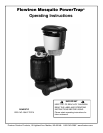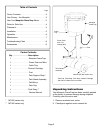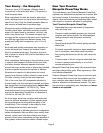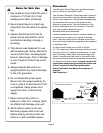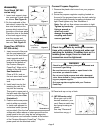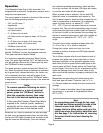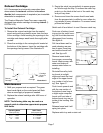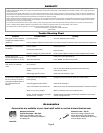
Page 3
Your Enemy – the Mosquito
There are some 2,700 species (different kinds of
mosquitoes) in the world with about 170 species in
North America alone.
Most mosquitoes live and die close to where they
hatch, although some can travel miles (kilometres) in
search of a host. Only the female mosquito bites as
she requires a blood meal to produce eggs.
Mosquitoes require standing water in aquatic habitats
including fresh water, salt water marshes, brackish
water or in water found in containers, old tires, tree
holes, even flower pots. The female mosquito lays
her eggs on the surface of the water and if conditions
are right the eggs hatch and become larvae, then
pupae and finally adult mosquitoes; all in 10 to 14
days.
Both male and female mosquitoes feed regularly on
nectar obtained from flowers, but females require
blood to produce fertile eggs. Therefore, she must
find a human or animal host to blood feed before she
can lay her eggs.
Most mosquitoes that emerge in the wild never come
in contact with humans but obtain blood from birds
and other animals. Mosquito species that breed
around the home remain close to where they hatched
and are regarded as pests and carriers of disease.
Mosquitoes in search of a blood meal use visual,
thermal and olfactory (odour) stimuli to locate a host.
Of these, olfactory cues are the most important.
Out of the more than 100 compounds detected in
human breath only two have been isolated and identi-
fied as significant mosquito attractants; carbon diox-
ide (CO2) and octenol (1-OCTEN-3-OL). These
attractants serve as long-range airborne attractants
and can be detected by mosquitoes at distances of
100 feet to 125 feet (30 - 40 m).
At close range, body heat, moisture and lactic acid
serve as terminal attractants. Certain species show
strong preferences for biting different parts of the
human body. This is thought to be related to local
skin temperature and lactic acid output.
The attractiveness of different persons to mosquitoes
varies substantially. Men are bitten more readily than
women, adults more often than children and larger
persons attract more mosquitoes perhaps because of
their greater relative heat and carbon dioxide output.
How Your Flowtron
Mosquito PowerTrap Works
The revolutionary new Flowtron Mosquito PowerTr a p
replicates the attractants mosquitoes use to locate, bite
and annoy humans. It does this by producing carbon
dioxide, heat and moisture and combining these stimuli
with octenol to create an attractant to mosquitoes.
Your Flowtron Mosquito PowerTrap:
• Replicates the human attractants of respiration,
odor and body heat.
• Converts readily available propane gas into heat,
moisture and carbon dioxide, the acknowledged
leading mosquito and attractants emitted by
humans.
• Special super bright LED motion lighting provides
added lure.
• Produces a powerful vacuum to draw mosquitoes
into a convenient, removable catch tray where
they quickly dehydrate and die for safe, clean dis-
posal.
• Contains state-of-the-art computer controlled elec-
tronics to operate automatically in one of four
modes selected by you.
Mosquito PowerTrap does away with ultraviolet lights
and high voltage killing grids. Most importantly, it kills
only female mosquitoes.
Flowtron Mosquito PowerTrap uses an exclusive plat-
inum catalyst that converts air and propane gas into
heat, moisture and carbon dioxide. It does this in an
efficient, effective and economical manner. The cata-
lyst converter is completely safe, flameless and never
needs to be replaced.



